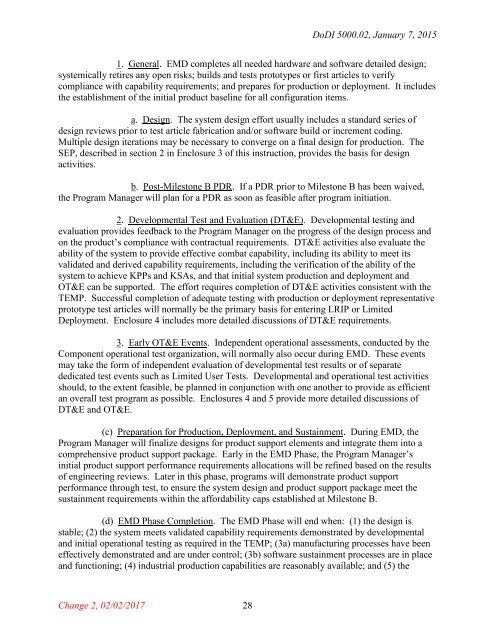Department of Defense INSTRUCTION
x9tnk
x9tnk
Create successful ePaper yourself
Turn your PDF publications into a flip-book with our unique Google optimized e-Paper software.
DoDI 5000.02, January 7, 2015<br />
1. General. EMD completes all needed hardware and s<strong>of</strong>tware detailed design;<br />
systemically retires any open risks; builds and tests prototypes or first articles to verify<br />
compliance with capability requirements; and prepares for production or deployment. It includes<br />
the establishment <strong>of</strong> the initial product baseline for all configuration items.<br />
a. Design. The system design effort usually includes a standard series <strong>of</strong><br />
design reviews prior to test article fabrication and/or s<strong>of</strong>tware build or increment coding.<br />
Multiple design iterations may be necessary to converge on a final design for production. The<br />
SEP, described in section 2 in Enclosure 3 <strong>of</strong> this instruction, provides the basis for design<br />
activities.<br />
b. Post-Milestone B PDR. If a PDR prior to Milestone B has been waived,<br />
the Program Manager will plan for a PDR as soon as feasible after program initiation.<br />
2. Developmental Test and Evaluation (DT&E). Developmental testing and<br />
evaluation provides feedback to the Program Manager on the progress <strong>of</strong> the design process and<br />
on the product’s compliance with contractual requirements. DT&E activities also evaluate the<br />
ability <strong>of</strong> the system to provide effective combat capability, including its ability to meet its<br />
validated and derived capability requirements, including the verification <strong>of</strong> the ability <strong>of</strong> the<br />
system to achieve KPPs and KSAs, and that initial system production and deployment and<br />
OT&E can be supported. The effort requires completion <strong>of</strong> DT&E activities consistent with the<br />
TEMP. Successful completion <strong>of</strong> adequate testing with production or deployment representative<br />
prototype test articles will normally be the primary basis for entering LRIP or Limited<br />
Deployment. Enclosure 4 includes more detailed discussions <strong>of</strong> DT&E requirements.<br />
3. Early OT&E Events. Independent operational assessments, conducted by the<br />
Component operational test organization, will normally also occur during EMD. These events<br />
may take the form <strong>of</strong> independent evaluation <strong>of</strong> developmental test results or <strong>of</strong> separate<br />
dedicated test events such as Limited User Tests. Developmental and operational test activities<br />
should, to the extent feasible, be planned in conjunction with one another to provide as efficient<br />
an overall test program as possible. Enclosures 4 and 5 provide more detailed discussions <strong>of</strong><br />
DT&E and OT&E.<br />
(c) Preparation for Production, Deployment, and Sustainment. During EMD, the<br />
Program Manager will finalize designs for product support elements and integrate them into a<br />
comprehensive product support package. Early in the EMD Phase, the Program Manager’s<br />
initial product support performance requirements allocations will be refined based on the results<br />
<strong>of</strong> engineering reviews. Later in this phase, programs will demonstrate product support<br />
performance through test, to ensure the system design and product support package meet the<br />
sustainment requirements within the affordability caps established at Milestone B.<br />
(d) EMD Phase Completion. The EMD Phase will end when: (1) the design is<br />
stable; (2) the system meets validated capability requirements demonstrated by developmental<br />
and initial operational testing as required in the TEMP; (3a) manufacturing processes have been<br />
effectively demonstrated and are under control; (3b) s<strong>of</strong>tware sustainment processes are in place<br />
and functioning; (4) industrial production capabilities are reasonably available; and (5) the<br />
Change 2, 02/02/2017 28


